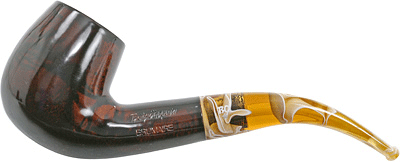Amber is one of a few gemstones of organic, rather than mineral, origin. Essentially, amber is a fossilized resin from prehistoric evergreens or other now-extinct species of resin-producing trees which flourished in large forests 40-60 million years ago.
As the resin flowed downward, it occasionally entrapped insects and plant species, and eventually accumulated in masses of various sizes and shapes that later became buried in the soil below the trees. Extreme conditions, such as pressure by glacier covering, severe climatic changes and submersion of the resin under salt water, took place over million of years, causing the process of oxidization. The volatile compounds which imparted “stickiness” to the resin escaped so slowly the resin was prevented from cracking into numerous minute fragments as a result of the shrinkage. During the lengthy time underground, molecules were forced to polymerize; that is, to rearrange themselves. This caused a metamorphosis from a tacky resin to a solid, forming a compound with greater stability and hardness than the original substance, and similar in appearance to plastic (in no way is amber identical – chemically or otherwise – to plastic, though plastic often masquerades as amber to the unsuspecting public).
Rough or “block” amber is commonly found in irregular lumps or rounded nodules, also in grains, drops and stalactitic masses. Pieces are generally small weighing up about 200 grams, although considerably larger masses have been found.
Amber is commonly yellow to honey-colored, but its hues range from white to light yellow (butterscotch) to reddish brown and green. Sometimes it is so pale that seems colorless. Approximately 250 different color varieties are known. In addition to variations of color, amber can be absolutely transparent or completely opaque.
When chips of amber are burnt, a smoke with pleasant resinous odour of pine is emitted, and for this reason amber was burnt as incense in temples in the Far East. If a lump of amber is rubbed vigorously, it produces enough negative static electrical charge to pick up small particles of tissue paper. The word electricity was actually derived from electron, the Greek name for amber. Unlike other minerals gemstones, amber is warm to the touch, since it is a poor conductor of heat.
Amber is water-insoluble tree resin which has attained a stable state after various changes due to loss of volatile constituents, processes such as oxidization and polymerization, and lengthy burial in the ground. The botanist is not concerned with the length of time to reach this state. It may take a year, thousands years, million years or more. The geologist considers amber to be a fossil tree resin, “fossil” meaning evidence of prehistoric life. The resin, then, must have been excluded from the tree at least before recorded history. The purist places even more restrictions up on the term amber. For him “true amber” is the fossil resin containing as much as 3% to 8% succinic acid (hence known as succinite) and coming from trees which flourished along shores of the Baltic Sea as long ago as 60 million years.
Gem-dealers and jewellers obviously are purists, since one pays the highest price for Baltic Amber. The geologist works to establish the age of the deposits in which the amber is found. The geologist works to establish the age of the deposits in which the amber is found. He also attempts to characterize the amber by its physical and chemical properties, and leans heavily upon aid from organic chemists to accomplish this. The botanist, naturally, is interested chiefly in the botanical sources of amber.
Patty C. Rice, Ph.D.







